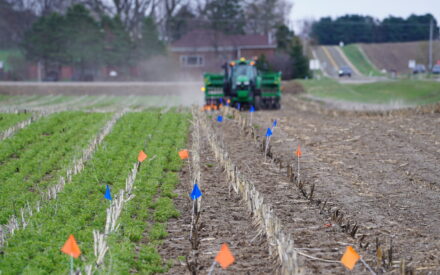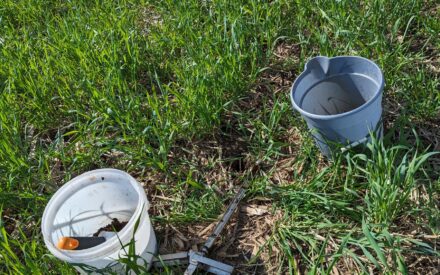Introduction
Diversifying and lengthening crop rotations can help producers improve pest management1. Incorporating wheat into Wisconsin’s dominant corn-soybean grain rotations can be used to manage pests by disrupting their life cycles and promoting beneficial natural enemies (e.g., predators and parasitoids) that carry out biological control and prevent pests from causing significant damage to crops.
Disrupting Pest Life Cycles
Incorporating wheat into a corn-soybean (CS) rotation helps control pests by disrupting their life cycles. This tactic is most effective against pests with a narrow host range, long life cycle, and limited mobility between fields. In Wisconsin, two “billion-dollar pests”—corn rootworm and soybean cyst nematode—fit these criteria and their management can be enhanced by incorporating wheat into CS rotations.
Corn Rootworm
Corn rootworms (CRW) are major pests of corn in Wisconsin. Northern (Diabrotica barberi) and Western (Diabrotica virgifera virgifera) CRW overwinter as eggs in the soil of cornfields, where the larvae feed on corn roots once they hatch. Rotating to a non-corn crop after corn can effectively control CRW by depriving the larvae of their food source. CRW are primarily a problem in fields where corn is grown continuously. Historically, farmers have managed CRW using two-year CS rotations and Bt-corn hybrids.
Both Northern and Western CRW, however, have developed adaptations to the CS rotation. Western CRW has developed a behavioral adaptation to rotation and will lay eggs in both corn and soybean fields. Overwintering eggs in soybean fields will hatch in a cornfield in the spring and larvae will damage the corn. Northern CRW have developed a genetic adaptation called extended diapause, which enables some of the eggs to remain dormant for two or more winters before hatching. In a two-year corn-soybean rotation, eggs that undergo extended diapause will hatch in the second year when corn is planted again, leading to corn damage. Each of these “variant CRWs” have been found in Wisconsin.
These variants emerged due to the widespread use of CS rotations across much of the Upper Midwest. Their presence has made managing CRW with CS rotations more challenging, highlighting the need to diversify and lengthen rotations. Adding wheat to the rotation can extend the time away from corn to two years and keep crop rotation as the foundation for CRW management. Even if variants are not a concern, longer rotations that use wheat significantly reduce the number of CRW in fields2.
Incorporating wheat into a CS rotation can also help slow the development of CRW resistance to Bt traits and/or insecticides because it extends the time between corn crops. With wheat in the rotation, CRW pests are seeing corn and these Bt traits and/or insecticides 1 out of every 3 years rather than 1 out of 2, reducing the selective pressure3. With an extended rotation that reduces variant CRW’s access to corn, farmers could even consider purchasing seed without CRW resistance. This could help save money on seed, as traits come with an added cost.
Soybean Cyst Nematode
Soybean cyst nematode (SCN; Heterodera glycines) is a nematode pest that feeds and reproduces on soybean roots. They are considered the most damaging pest to soybeans in the USA4. In Wisconsin, about 25% of soybean fields are infested with SCN and yield losses have been documented for over 25 years4. There is no way to eliminate SCN once it has infested a field, but they can be managed using resistant soybean varieties, nematicides, and a diverse crop rotation.
Rotating soybean with non-host crops is used to control SCN in infested fields. Whenever non-host crops are grown, the reservoir of SCN eggs in the soil is decreased. Many crops are non-hosts, including corn and several small grains like barley, oats, and wheat4. Planting corn after soybeans in the typical CS rotation will help reduce SCN eggs in the soil, but diversifying and lengthening the rotation with wheat can extend the time between soybean crops even further. Rotations with higher frequencies of soybean have higher egg reservoirs compared to other rotations5, and corn has been shown to be one of the worst non-host crops for reducing SCN populations6.
Extending CS rotations with wheat is a more effective rotation for reducing SCN egg densities in infested fields. Selecting suitable non-host crops for extended rotations is important for managing SCN, but equally critical is rotating SCN-resistant soybean varieties within that rotation. Changing resistant varieties helps prevent SCN populations from adapting to and overcoming resistance. For detailed guidance on rotating sources of genetic resistance, visit the Soybean Cyst Nematode Coalition. Effective SCN management ultimately requires an integrated approach, combining genetic resistance rotation and extended crop rotations with more non-host crops, like wheat, between soybean plantings in infested fields.
Promoting Natural Enemies and Biological Control
In agricultural systems, natural enemies like ground beetles, parasitoids, hoverflies, lacewings, wasps, and lady beetles play an important role in controlling pest populations via biological control. Biological control provided by natural enemies is valued at $7 billion annually7 (2024 dollars). More diverse rotations can be used to promote natural enemies1. They support natural enemy populations by improving in-season refuges, increasing in-field overwintering habitat, providing extra food resources that aren’t pests (e.g., pollen, nectar, non-pest alternative prey), and enhancing movement within fields and across the landscape8.
Continuous cropping and short, 2-year rotations have fewer natural enemies compared to extended rotations that include a small grain like wheat2,9,10,11. A long-term study comparing a CS rotation to more diverse rotations showed that extending the CS rotation with a winter wheat crop increased natural enemy abundance (e.g., a 43% increase in predatory ground beetles) and decreased pest populations10. Reducing the time a field is fallow by growing a winter crop promotes natural enemies.
Another long-term cropping study examining the diversification of dairy rotations observed that a rotation of corn, soybeans, winter wheat, and cover crops had more natural enemies that controlled early-season crop pests better than a standard CS rotation11. These findings highlight the benefits of extending crop rotations with wheat, which enhance natural enemy populations and improve pest control compared to shorter, less diverse rotations.
The positive effects of rotational diversity on natural enemies and biological control can be enhanced by using insecticides only when necessary based on economic injury thresholds of the pest2,11. Insecticides will kill beneficial natural enemies in addition to the target pest. Natural enemies are highly sensitive to broad-spectrum insecticides, and their resurgence (recovery to pre-spray densities) is usually much slower than that of pest populations. Maximizing the contributions of natural enemies to pest control requires a multi-faceted, integrated approach that includes diverse crop rotations and judicious insecticide use.
Conclusion
Incorporating wheat into CS rotations can disrupt pest life cycles and support the role of natural enemies in biological control. Producers wishing to enhance populations of beneficial insects should develop cropping systems with several different crops in the rotation and minimal insecticide use. Wider adoption of diversified crop rotations by farmers enhances biological control at a landscape scale by creating a more complex and varied mosaic of crops12. Using wheat to diversify CS crop rotations can act as a strong foundation for more effective, economic, and sustainable pest management.
References
- Jaworski, C.C., Thomine, E., Rusch, A., Lavoir, A. Wang, S., Desneux, N. 2023. Crop diversification to promote arthropod pest management: a review. Agricultural Communications (1)1: 100004.
- Brust, G.E., King, L.R. 1994. Effects of crop rotation and reduced chemical inputs on pests and predators in maize agroecosystems. Agriculture, Ecosystems and Environment. 48(1): 77-89.
- Carriere, Y., Brown, Z., Aglasan, S., Dutilleul, P., Carroll, M., Head, G., Tabashnik, B.E., Jorgenson, P.S., Carroll, S.P. 2020. Crop rotation mitigates impacts of corn rootworm resistance to transgenic Bt corn. Proceedings of the National Academy of Sciences. 117(31): 18385-18392.
- Soybean cyst nematode coalition. https://www.thescncoalition.com/state-information/university-coalition-experts/university-of-wisconsin/
- Wright, J.P., Allen, F.L., Donald, P.A., Tyler, D.D., Saxton, A.M. 2018. Impact of crop rotation and bio-covers on soybean cyst nematode. Plant Health Progress 12 (1).
- Miller, D.R., Chen, S.Y., P. M., Porter, G.A., Johnson, D.L., Wyse, S.R., Stetina, L.D., Klossner, G.A., Nelson. 2006. Rotation crop evaluation for management of the soybean cyst nematode in Minnesota. Agronomy Journal. 98 (3), 569-578.
- Losey, J.E., Vaughan, M. 2006. The economic value of ecological services provided by insects. BioScience 56(4): 311-323.
- G.M. Gurr, S.D. Wratten, D.A. Landis, M. You. 2017. Habitat management to suppress pest populations: progress and prospects. Annual Review of Entomology. 62: 91-109.
- O’Rourke, M.E., Liebman, M., Rice, M.E. 2008. Ground Beetle (Coleoptera: Carabidae) Assemblages in Conventional and Diversified Crop Rotation Systems. Journal of Economic Entomology. 37(1): 121-130.
- Witmer, J.E., Hough-Goldstein, J.A., Pesek, J.D. 2003. Ground-dwelling and foliar arthropods in four cropping systems. Environmental Entomology. 32(1): 366-376.
- Busch, A.K., Douglas, M.R., Malcom, G.M., Karsten, H.D., Tooker, J.F. 2020. A high diversity/IPM cropping system fosters beneficial arthropod populations, limits invertebrate pests, and produces competitive maize yields. Agriculture, Ecosystems and Environment. 292: 106812.
- Rusch, A., Chaplin-Kramer, R., Gardiner, M.M., Hawro, V., Holland, J., Landis, D., This, C., Tscharntke, T., Weisser, W.W., Winqvist, C., Woltz, M., Bommarco, R. 2016. Agricultural landscape simplification reduces natural pest control: a quantitative synthesis. Agriculture, Ecosystems & Environment. 221, 198–204.
Updated: Aug. 15, 2025
Reviewed by: Shawn Conley

 Small Grains Economics
Small Grains Economics ▶ Unlocking the Potential of Biological Nitrogen Fixation in Corn
▶ Unlocking the Potential of Biological Nitrogen Fixation in Corn ▶ Considerations for 2026 Seed Selection
▶ Considerations for 2026 Seed Selection ▶ Evaluating MRTN Rates for Corn Grain and Silage After Manure Application
▶ Evaluating MRTN Rates for Corn Grain and Silage After Manure Application


